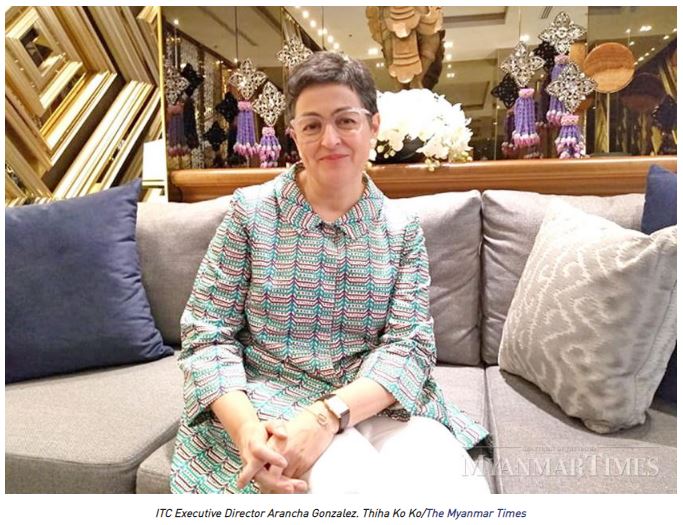Myanmar: Adding value to local produce for better export earnings
Under the updated National Export Strategy 2020-2025, Myanmar is targeting total trade volumes of US$31 billion for the current fiscal year, with US$15.3 billion for exports and US$15.8 billion for imports. If successful, this would reduce the trade deficit to US$500 million.
To boost trade volumes and expand exports, Myanmar this month launched the Trade and Investment Project (TIP), which will help to improve the trade environment by expanding public and private investment support services to micro, small and medium enterprises.
The TIP, which would run from 2019-21, is funded by a US$5.28 million grant from the UK’s Department for International Development (DFID) and enjoys technical support from the International Trade Centre (ITC).
ITC Executive Director Arancha Gonzalez discussed the prospects and challenges for Myanmar’s export sector in an exclusive interview after the launch of TIP on March 4:
Is there a possibility for Myanmar to become a high-quality product exporter over the next 1-3 years?
Myanmar has potential to become a value-add exporter of goods. But the country’s current situation is very weak, contrary to its real potential. For example- worldwide demand for honey and honey-based products is increasing. To leverage on this for better export revenues, we will need to produce finished products for better value. Besides exporting raw honey, we need to produce and export snacks, drinks and cosmetics made of honey for higher value.
Given that the current National Export Strategy (NES 2015-2019) will be updated to NES 2020-2025 soon, based on the past, what needs to improve in the next five years?
NES 2015-2019 has helped in trade development. It was launched in 2014 when Myanmar’s economy was just opening up. Five years later, exports have improved and exceeded the average export level in ASEAN.
However, the export amount is still lacking when compared against the prospects and potential of the country. Therefore, we have to focus more and work harder in the next five years. For example, the tourism sector has achieved success. We carried out tourism development in Kayah State and the number of travelers increased from 300 to 70,000 over the past five years. Each sector will need support, investment and time to grow.
What needs to be done to improve agricultural exports?
In the agricultural sector, the important thing for Myanmar is to be able to export finished products rather than the raw commodities. For example, exporting honey products or coffee products instead of just raw honey or raw coffee beans.
The difference is that the price of raw materials is very low and the price of the finished products will be higher. When the raw materials are processed into finished products, earnings of the farmers will improve and better job opportunities will emerge as we move up the value chain.
The government will add fruits and vegetables, gems and jewelry, handicrafts, processed food products and digital business as potential export sectors to prioritise under the NES 2020-2025. What is your opinion on the new categories of exports included in the updated NES?
The view of the government is right as these new sectors included in the updated NES have been prioritised after discussions between the government and private sector.
What is necessary for improving the quantity and quality of our exports?
What is important is how much value-added products can be produced. In international trade, quality rather than quantity is important. Export revenues from processing raw materials into finished products are better than that of handling and exporting the commodities raw. It also creates many job opportunities along the production chain. Three things need to be improved when it comes to Myanmar’s exports – value-addition, expertise and innovation.
What should be done to sustain the current rise in exports?
The main thing to do is to help support local small and medium enterprises and to keep abreast with international demand trends. Most Myanmar businesses are small. Some are micro. The focus should be on promoting and helping the small progress to become the medium. We need to help them be more competitive and encourage them to take part in international trade.
What can be done to expand the industry for import substitutes and narrow the trade deficit?
Myanmar is a country which imports more than it exports. But this does not have to be an issue. For example, we need to import capital goods because they can be used for producing value-added goods. But if the taxes levied on the import of capital goods are high, these goods will become expensive and will have an impact on the end products they are used to make, such as food and cosmetics.
What advice would you give to the government and private sector to help the trade sector develop more?
The government’s policies, rules and regulations, financial support systems and other practices have to be realistic and aligned with the economy’s needs. Infrastructure built by the government has to meet the requirements of the workplace.
The private sector also needs to have courage to take some calculated risks to compete with international producers. But the courage to take risks also depends on the availability of financial assistance, which should also improve in the years ahead.
Source: https://www.mmtimes.com/news/adding-value-local-produce-better-export-earnings.html


 English
English




